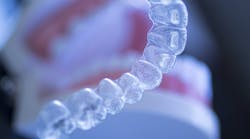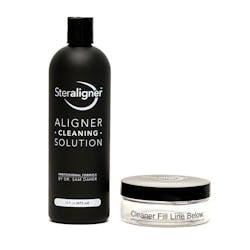I am fascinated by the human brain. I speak and write about the prevention of cognitive decline to anyone who will listen. There has been a leading hypothesis that Alzheimer's is caused by the buildup of sticky amyloid plaques and misfolded tau proteins in the brain, which break down communication between neurons and lead to memory loss, cognitive decline, and eventually death.1-4 However, there is a new sheriff in town: the antimicrobial protection hypothesis. Certain viruses, microbes, and bacteria are suspected of triggering the plaque buildup that is indicative of the immune system trying to protect the brain.5 We don’t yet know whether the microbes are causative or merely passengers, but we’re certain that less bacteria means less inflammation, and therefore improved brain health.
Some of the implicated pathogens are spirochetes, candida albicans, and Herpes Simplex 1.6-8 As a dental hygienist elbow deep in bacterial bugs every day, I concern myself with how to decrease the load for my patients. We treat gum disease and work to reduce decay, but we should be just as concerned with the cleanliness of the abundance of removable apparatuses administered to help with sleep disordered breathing, grinding problems, changing alignment or occlusion, and replacing missing teeth with dentures and partials. Every removable tool is teeming with potential disease-contributing bacteria. I personally see the danger of many of my senior patients developing yeast issues not only in their mouths but on their removables as well.
I became aware of Steraligner because my teenage son wears aligners. Like many teens, his oral hygiene isn’tTrevor Hier, chief marketing officer with Plaque HD, defines their formulation attributes as: "A combination of proprietary surfactant blends with maximum efficacy to remove and suspend built-up stains and hardened films/plaque, then spontaneously keep them suspended by altering their ionic charge to avoid re-deposition of the suspended soil onto the aligner surface. In addition, the blend of natural essential oils with antiseptic properties helps to sanitize and refresh the aligners after the very first application, and continues to deodorize and refresh after each application. A special combination of descaling agents dislodges and removes white buildup immediately.”
The cleaner is cost effective because there is no excess waste. Just dispense a small amount to a fill line, add a bit of water, and clean. There is a slight minty taste after you rinse the aligners, but more importantly, 99% fewer bacteria, making the aligner virtually bacteria free. There are many choices on the market for cleaning devices, and even products used in dental offices don’t miraculously clean every device all of the time. However, regular use of a product such as Steraligner that removes bacteria from dental devices is truly a benefit to whole body health for our patients.
Steraligner cleaning solutions are available in 16-ounce bottles, or in TSA-approved 3.2-ounce bottles. The kit includes a soaking dish and cap that can be used for storage. One 16-ounce bottle should last approximately 30 days.
Steraligner is part of a product line that includes Sterasmile, an alcohol-free foaming solution that sanitizes aligners in 60 seconds, and Sterabrush, a cleaner and sanitizer for toothbrushes that works in under a minute. Both Sterasmile and Sterabrush use xylitol as an active ingredient.
We are valuable healthcare providers with many tools in our arsenal to help patients achieve better health. Reducing bacteria and inflammation is key to overall wellness, and I am thrilled to be armed with a product that can help everyone reach that goal.
Please visit steraligner.com for more information.
References
- Hardy J, Allsop D. Amyloid deposition as the central event in the aetiology of Alzheimer's disease. Trends Pharmacol Sci. 1991;12(10):383‐388. doi:10.1016/0165-6147(91)90609-v
- Mudher A, Lovestone S. Alzheimer's disease—do Tauists and Baptists finally shake hands? Trends Neurosci. 2002;25(1):22‐26. doi:10.1016/s0166-2236(00)02031-2
- Goedert M, Spillantini MG, Crowther RA. Tau proteins and neurofibrillary degeneration. Brain Pathology. 1991; 1(4): 279–86. doi:10.1111/j.1750-3639.1991.tb00671.x
- Chun W, Johnson GV. The role of tau phosphorylation and cleavage in neuronal cell death. Front Biosci. 2007;12:733‐756. Published 2007 Jan 1. doi:10.2741/2097
- Moir RD, Lathe R, Tanzi RE. The antimicrobial protection hypothesis of Alzheimer's disease. Alzheimers Dement. 2018;14(12):1602‐1614. doi:10.1016/j.jalz.2018.06.3040
- Miklossy J. Alzheimer's disease - a neurospirochetosis. Analysis of the evidence following Koch's and Hill's criteria. J Neuroinflammation. 2011;8:90. Published 2011 Aug 4. doi:10.1186/1742-2094-8-90
- Wu Y, Du S, Johnson JL, et al. Microglia and amyloid precursor protein coordinate control of transient candida cerebritis with memory deficits. Nat Commun. 2019;10(1):58. Published 2019 Jan 4. doi:10.1038/s41467-018-07991-4
- Piacentini R, De Chiara G, Li Puma DD, et al. HSV-1 and Alzheimer's disease: more than a hypothesis. Front Pharmacol. 2014;5:97. Published 2014 May 7. doi:10.3389/fphar.2014.00097
- PLC Laboratories. Bacteria reduction—study summary. Steraligner-commissioned study completed 2017.








